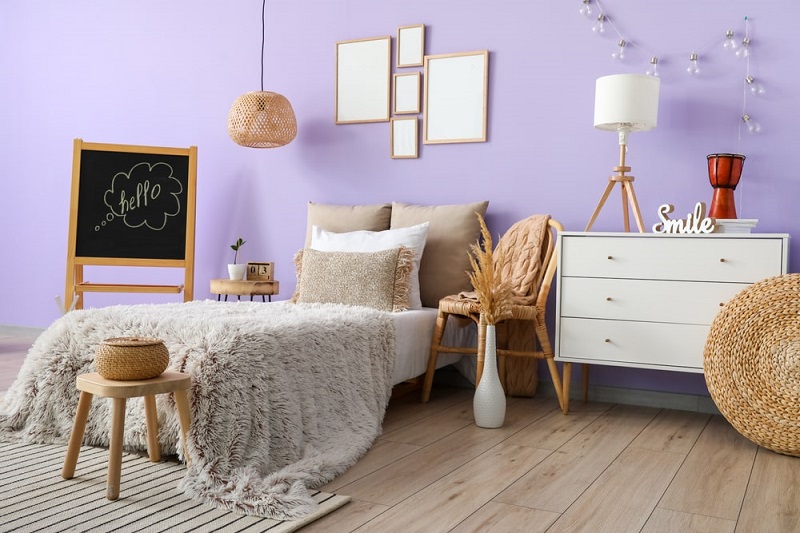
8 relaxing colors for the bedroom
The more relaxed the colors of a room, the more pleasant the rest will be. Learn about the ones that contribute to the desired tranquility in a bedroom.
Pleasant sleep at night determines optimal performance. For this reason, proper rest needs allies such as a good mattress, the ideal temperature, and relaxing colors for the bedroom.
If the mat is old or deteriorated, then it makes us uncomfortable. In rooms where it is too cold or too hot, it is difficult to get a good night’s sleep. For its part, the walls painted in garish tones do not help you sleep well.
Instead, soft tones make up a space that is nice to relax in. This happens because color influences mood, behavior, and sleep. The last particularity is the one we will address.
Colors and their influence on mood
The subconscious assimilates a meaning for each color. This is how they help to calm down in stressful situations or encourage sadness.
According to a publication by the Tecnologico de Monterrey, it has been shown that colors affect emotional, psychological, and physical states. In turn, the tones play with perception and directly or indirectly influence mood.
The importance of selecting relaxing colors for the bedroom
A work released by the Vic School of Art specifies that color stimulates or represses, makes happy or sad, and also has the power to awaken passive or active attitudes. The text adds that the colors favor thermal sensations and convey the impression of order or disorder.
These characteristics are related to what is expected of the environment in a bedroom. These rooms require a pleasant atmosphere to make the most of the hours of sleep.
The Journal of Physiological Anthropology and Applied Human Sciences reports that light sources with higher color temperatures affect the quality of rest. And as the National Institutes of Health (NIH) explains, sleep maintains the body’s energy balance, intellectual function, alertness, and mood.
Take note of the best relaxing colors for the bedroom
Understanding that getting enough rest keeps people healthy, it’s a good idea to set up your environment so that rest actually restores. Bedrooms are sanctuaries that demand tranquility. In addition to sleeping, you can exercise, meditate or do yoga in them .
Whatever the practice, the effects are enhanced if the room has colors that lead to relaxation.
1. White
White symbolizes peace. It is a color that favors lighting, is linked to neatness, and promotes serenity, essential for falling asleep at night and relaxing during the day.
Pure white is the lightest color in the spectrum, but it has multiple variations:
- Whiteboard.
- Oyster.
- Pearl.
- Ivory.
- Bone.
- Cream.
2. Beige
Decorations in light beige or neutral provide more warmth than white. It is also a serene color, appropriate for both adults’ and children’s rooms. The discretion of this tone lends itself to playing with striking furniture, perhaps in a more intense beige or in soft yellows.
3. Pink
The variety of the pink color is summed up in balanced and welcoming. The pastel range or the “pale pink” convey relaxation and sweetness. Pink environments are ideal to disengage a bit from the daily whirlwind.
In general, this color is mixed with others, such as white and gray, to reduce saturation and increase relaxation. Accessories or furniture in such pigments works to complement the style of the bedroom.
4. Blue
Blue is a color related to energy. Above all, the light range transmits calm and evokes the sea and the sky. This tone promotes concentration, security and serenity.
Blues are believed to minimize tensions and feelings of fear. The color is one of the most relaxing to sleep; even in strong tones.
5. Soft yellow
Yellow is a positive color, of light and joy; characteristics that do not detract from its relaxing qualities. As long as you opt for the soft range of this palette, you will obtain tranquility in the bedroom, because they are tones that allude to the sun’s rays in a quiet space.
6. Green
Green is the color of vitality and one of the most beneficial for rest. It is linked to nature, hope and life . If there is a tone that provides freshness, that is green.
The pigments in this range relax the eyes, enhance feelings of security, and are pleasing to the mind and body. Fewer bright palettes help to rest better because they activate a stillness effect.
7. Gray
Gray tones are associated with simplicity. Decorative trends often include them in their palettes because it is a color with relaxing qualities, especially for adult rooms.
Gray is neutral, modern, and elegant. Light, with a tendency to be silver or more intense, this pigment provides a feeling of spaciousness and comfort.
8. Lilac
Lilac palettes are all about calm and poise. Like violet and light purples, lilac is synonymous with luxury; they tend to link them with spirituality and wisdom.
Calming, creativity-stimulating, and sleep-promoting properties are attributed to this color. As it is a pigment with a higher proportion of cold tone, it gives relief effects.
Architectural Digest magazine validates the fact that cool colors have meditative and relaxing reactions on the mind, perfect for warding off stress and relieving anxiety.
The advantages of combining relaxing colors for the bedroom
There is no rule that restricts bedrooms to wearing a single color to relax. There are contrasts consistent with the purpose and good taste.
An alternative is to combine white tones with wood, taking advantage of the furniture, the floor, and the decorative elements. Being a natural material, wood stains are comfortable and provide a special appeal.
Mauve tones go very well with vanilla and cream, pink winks with beige and white, while greens convey calm by fusing them with white, blue, or earth pigments.




